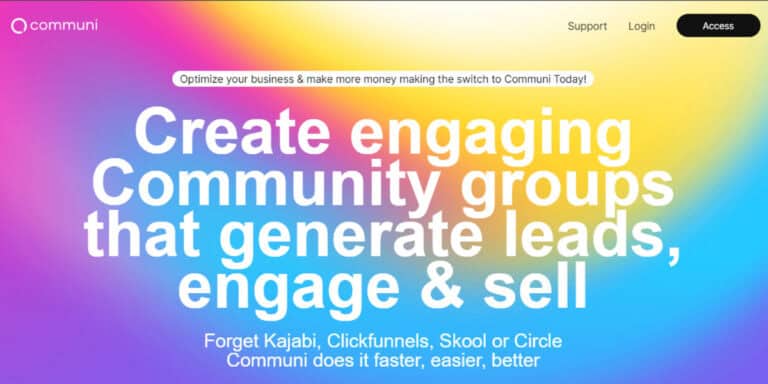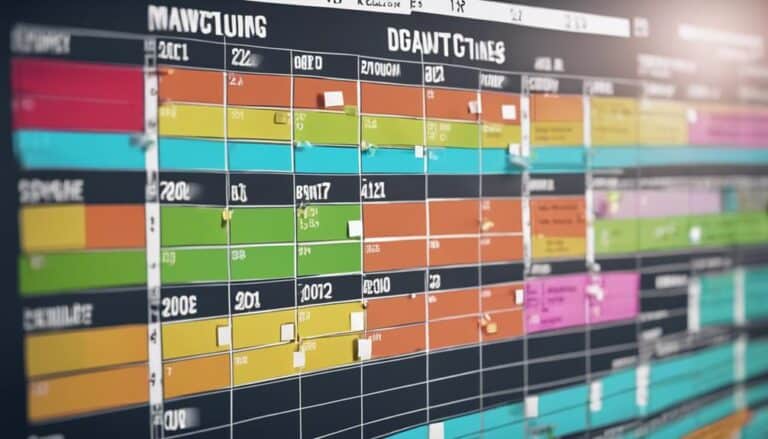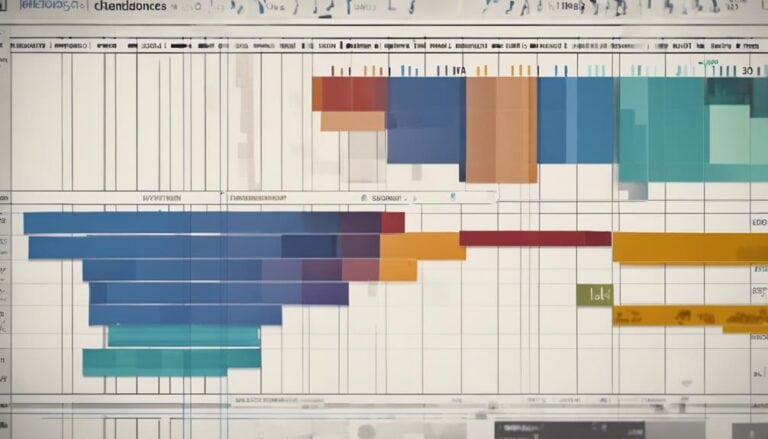As you navigate the realm of project management, you may find yourself at a crossroads between traditional and adaptive strategies.
The question arises: which path holds the key to unlocking your project's full potential?
By understanding the nuances of both methodologies, you can strategically align your approach with the dynamic demands of the modern business landscape.
Let's explore how each strategy shapes project outcomes and discover the critical factors that could redefine your project management journey.
Key Takeaways
- Agile project planning emphasizes flexibility and adaptability, while waterfall planning follows a linear, sequential approach.
- Scope management in agile projects involves continuous collaboration and adjustments, whereas waterfall projects require meticulous upfront planning for scope control.
- Time management in agile focuses on iterative timeboxing and incremental delivery, while waterfall projects rely on predetermined timeframes and sequential phases.
- Adaptive strategies in agile planning promote flexibility, adaptability, and continuous improvement, contrasting with the rigidity of waterfall planning.
Agile Project Planning Overview
When implementing Agile project planning strategies, teams prioritize flexibility, adaptability, and continuous improvement throughout the project lifecycle.
Agile iteration cycles are a key component of this approach, allowing teams to break down projects into smaller, more manageable tasks known as user stories. These cycles enable iterative development, where feedback is gathered regularly, and adjustments can be made promptly.
Adaptive project structures are another hallmark of Agile methodologies like Scrum, Kanban, and Lean. These structures promote transparency, collaboration, and the incremental delivery of value to stakeholders.
Waterfall Project Planning Overview
Waterfall project planning is characterized by a linear, sequential approach that mandates the completion of each phase before progressing to the next. This method involves detailed planning upfront, with clear requirements established at the project's inception. Here are some key points to consider:
- Rigidity: The sequential approach in waterfall projects can lead to rigidity, making it challenging to incorporate changes once the project is in progress.
- Clarity: Detailed requirements set at the beginning provide a clear roadmap for the project, aiding in better understanding and planning.
- Tracking Progress: Well-defined milestones and deliverables make it easier to track progress throughout the project lifecycle.
- Suitability: Waterfall is best suited for projects with stable requirements and where a step-by-step, predictable process is preferred.
Understanding these aspects of waterfall project planning can help you assess its suitability for your specific project needs.
Scope Management in Agile Projects
Scope management in agile projects involves continuous collaboration with stakeholders to define and prioritize project requirements, ensuring flexibility and alignment with evolving scope. Agile methodologies stress the importance of stakeholder collaboration and prioritization to guarantee that the project remains on track and delivers value. Continuous adjustments are a key feature of agile projects, allowing teams to adapt to changing requirements swiftly. This adaptability is achieved through iterative planning and review cycles, enabling teams to align their deliverables and timelines with the evolving scope. Agile frameworks such as Scrum and Kanban offer tools like backlogs and visual boards to aid in managing scope effectively. Communication and feedback loops are essential components of agile projects, ensuring that all team members have a clear understanding of the scope requirements and any necessary adjustments.
| Key Aspects | Description | Importance |
|---|---|---|
| Stakeholder Collaboration | Involving stakeholders in defining and prioritizing requirements ensures project alignment and customer satisfaction. | High |
| Continuous Adjustments | The ability to make ongoing changes based on evolving scope guarantees project adaptability and relevance. | Critical |
| Flexibility | Agile's emphasis on flexibility allows for responsiveness to changing needs, resulting in a more successful project outcome. | Essential |
Scope Management in Waterfall Projects
To effectively manage project requirements in a waterfall methodology, meticulous upfront planning and documentation are imperative for maintaining scope integrity and minimizing changes throughout the project lifecycle.
In waterfall projects, scope control is paramount to ensure alignment with the predetermined criteria and prevent scope creep. Requirement documentation, in the form of a detailed requirements document, plays a crucial role in providing clarity and serving as a reference point throughout the project.
By adhering to a fixed scope and discouraging changes once the project is in progress, waterfall projects aim to deliver on the initial project vision without deviations.
Thorough planning and analysis in the early stages are essential for establishing a clear scope and minimizing alterations during the project's execution. Following a sequential, step-by-step approach allows for a structured progression that aligns with the defined scope, ultimately contributing to successful project outcomes.
Timeframe Considerations in Agile
When considering timeframes in Agile, you must comprehend the significance of Agile Sprint Duration, Iterative Timeboxing Approach, and Time Management Techniques. These elements play a pivotal role in ensuring the success and adaptability of Agile projects.
Agile Sprint Duration
Considering the dynamic nature of Agile projects, determining the optimal sprint duration plays a crucial role in fostering adaptability and efficiency within the team. Agile sprints typically range from 1-4 weeks, with 2-week sprints being most common. Here are some key considerations to keep in mind when setting the sprint duration:
- Sprint efficiency: Shorter sprints can enhance team collaboration and productivity.
- Delivery frequency: Shorter durations promote quicker delivery cycles and feedback loops.
- Adaptability: Shorter sprints allow for more flexibility in responding to changing requirements.
- Complexity: Longer sprints may be beneficial for intricate projects requiring extended development and testing phases.
Experimenting with different sprint lengths can help optimize productivity and project outcomes.
Iterative Timeboxing Approach
Implementing an iterative timeboxing approach in Agile projects ensures structured delivery within fixed timeframes, fostering efficiency and adaptability. Each iteration, lasting 1-4 weeks, promotes incremental delivery through iterative development. This method breaks down work into manageable chunks, allowing teams to focus on delivering a potentially shippable product increment at the end of each iteration.
Timeboxing enables prioritization, maintains a sustainable pace, and facilitates adaptation to changing requirements. By emphasizing transparency, collaboration, and continuous improvement, Agile timeboxing encourages regular feedback and reflection. Teams can manage risks effectively and respond promptly to stakeholder needs due to the time-constrained nature of Agile iterations.
This approach ensures value is delivered incrementally, enhancing project outcomes and stakeholder satisfaction.
Time Management Techniques
To effectively manage time in Agile projects, it's essential to employ structured techniques that promote efficiency and focus. When considering time management techniques in Agile, there are key strategies to keep in mind:
- Task Prioritization: Ensuring that tasks are prioritized based on their business value helps in delivering the most critical features first.
- Dynamic Scheduling: Agile projects require adjusting schedules dynamically to accommodate changing requirements and priorities.
- Incremental Delivery: By delivering value in small increments, Agile teams can continuously provide tangible outcomes.
- Adaptive Scheduling: Being able to adapt and reorganize the schedule based on feedback and evolving needs is crucial for successful Agile time management.
Timeframe Considerations in Waterfall
When managing projects using the Waterfall methodology, careful attention to the predetermined timeframes for each phase is crucial for successful project execution. In Waterfall, fixed timelines are established at the project's onset, with distinct sequential phases such as requirements gathering, design, implementation, testing, and deployment. These predefined timeframes for each phase are essential for maintaining the project's structure and progression.
The rigid nature of fixed timelines in Waterfall poses both advantages and challenges. On one hand, having clear milestones can provide a structured roadmap for the project team, aiding in planning and resource allocation. However, the inflexibility of these timeframes makes it difficult to accommodate changes in requirements or unexpected issues that may arise during the project lifecycle.
Moreover, delays in one phase can have a domino effect on subsequent phases, potentially leading to timeline disruptions and project bottlenecks. Therefore, meticulous planning and accurate estimations are paramount in Waterfall to ensure adherence to the established schedule and successful project delivery.
Flexibility in Agile Planning
In Agile planning, flexibility and adaptability are key components that empower project teams to swiftly respond to changes in project management. Agile planning allows for adaptive decision-making, where teams can adjust their strategies promptly based on evolving project requirements.
Agile team dynamics play a crucial role in fostering collaboration, communication, and shared responsibility among team members, enhancing overall project agility. This approach emphasizes iterative development, enabling frequent reassessment and adjustment of project goals and deliverables to ensure alignment with customer needs.
Agile planning also encourages continuous improvement through regular feedback loops and retrospective meetings, fostering a culture of learning and innovation within the team. By prioritizing the delivery of high-value features early and frequently, Agile planning ensures customer satisfaction and project success through incremental value delivery.
Rigidity in Waterfall Planning
The inflexible nature of waterfall planning restricts the ability to adapt to changing project requirements efficiently, hindering overall project success. Waterfall projects face significant flexibility challenges due to their linear structure, which lacks the adaptability needed to respond to evolving needs. The rigid framework of waterfall planning demands detailed upfront planning, making it challenging to incorporate changes as the project progresses. Late alterations in requirements or scope can result in costly and time-consuming adjustments, impacting project timelines and deliverables. This lack of adaptability constraints can lead to delays and inefficiencies, especially when compared to more agile and adaptive project strategies. The table below highlights key differences between waterfall planning and adaptive strategies:
| Feature | Waterfall Planning | Adaptive Strategies |
|---|---|---|
| Flexibility | Limited | High |
| Adaptability | Low | High |
| Change Management | Challenging | Embraced |
Frequently Asked Questions
How Do Team Dynamics Differ Between Traditional Waterfall and Adaptive Agile Project Strategies?
In traditional waterfall projects, team dynamics often follow a linear structure with limited collaboration. Agile projects promote constant team interaction, empowering members in decision-making processes. This shift fosters adaptability and quick responses, enhancing overall project outcomes.
What Are the Common Challenges Faced When Transitioning From a Waterfall to an Agile Project Strategy?
Navigating the shift from waterfall to agile poses challenges like adjusting team dynamics, embracing flexibility, and fostering continuous communication. Recognize these hurdles early, strategize your approach, and cultivate a culture open to change for a smoother transition.
How Do Communication Strategies Vary Between Traditional and Adaptive Project Approaches?
In traditional project approaches, communication is often hierarchical and formal, focusing on status updates and reports. In adaptive strategies, communication styles are more interactive and flexible, emphasizing collaboration techniques, quick decision-making processes, and real-time feedback mechanisms to facilitate project success.
What Are the Key Factors to Consider When Deciding Between a Traditional or Adaptive Project Strategy for a Specific Project?
Consider project flexibility for adaptability and resource allocation. Evaluate project scope for alignment and change management. Balancing these factors can help you decide between a traditional or adaptive project strategy for your specific project needs.
How Do Traditional and Adaptive Project Strategies Impact Stakeholder Engagement and Buy-In Throughout the Project Lifecycle?
When choosing between traditional and adaptive project strategies, consider how stakeholder involvement can impact project success. Engaging stakeholders throughout the project lifecycle builds buy-in and ensures alignment with project goals, increasing the likelihood of successful outcomes.
Conclusion
As you reflect on the comparison between traditional and adaptive project strategies, you're now equipped with the knowledge to navigate the complexities of project management effectively.
Remember, the key to success lies in embracing the flexibility of agile planning while also recognizing the importance of structure in waterfall planning.
With this newfound understanding, you're poised to conquer any project challenge with the precision of a master strategist.





